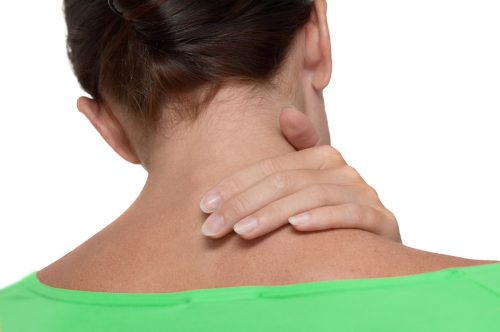Le whiplash ou post-traumatic acute neck pain is a fairly frequently encountered cervical injury. Fortunately benign in most cases, whiplash can, however, be a source of prolonged discomfort.
But then what is whiplash? What are its causes and symptoms? And how is it supported?
Definition
Le whiplash or " whiplash “denotes pain” neck pain » brutal caused by a trauma occurring in the cervical part of the spine or spine.
The consequences vary enormously depending on the shock, ranging from recovery without sequelae (when treatment is fast and appropriate) to severe damage and serious complications.
It is generally secondary to a sudden movement of acceleration followed by deceleration of the head during a slight car accident, for example. However, there are many other causes that can lead to cervical trauma.
Causes of Whiplash
Being essentially the consequence of a cervical trauma, the main causes of whiplash are dominated by accidents having an impact on the neck. Notably :
- Un traffic accident with a shock impacting the rear or the lateral side of the car thus generating a rapid and brutal movement of flexion extension. This will stiffen the upper cervical in flexion and the lower cervical in extension associated in some cases with a sprain or a vertebral fracture.
- The fall-type accidents particularly observed during the practice of certain contact sports, such as boxing or rugby, skiing, rallying, etc.
- Following blows and violence worn on the neck and face.
The mechanism of onset may differ depending on the cause and intensity of the shock causing the neck pain. Indeed, the shock will transmit a sound wave according to its origin (if it comes from the rear, the most frequent case, it will be transmitted from rear to front) and the cervical spine will have to undergo it in a fairly short period of time.
In addition to achieving cervical vertebrae (which will be blocked in flexion for the highs and in extension for the lows), the intervertebral discs can also be moved or damaged.
Since the cervical and intervertebral discs alone are not always able to withstand the shock, the cervical muscles can reflexively contract in response to a rapid stretch and cause neck stiffness.
Finally, the dura mater, a rigid fibrous membrane surrounding and protecting the central nervous system can also be affected and cause multiple symptoms.
This is explained by the fact that it is inserted at the base of the skull on, among others, the first two cervical vertebrae (atlas and axis) which are the first and most frequently affected during a whiplash. Consequently, the shock wave can reach this membrane and cause tensions at its level.
Diagnostic
The cervical region represents anatomically a true vascular and nervous crossroads. It is indeed at its level that the multiple vessels and nerves used to irrigate and innervate the upper limbs, the thorax and the head pass.
Consequently, a trauma at its level requires the performance of a meticulous clinical examination in order to diagnose any lesion that may be life-threatening or functional.
Given the variation of symptoms from one individual to another and their diversity, it can sometimes be difficult to make the diagnosis with certainty.
During the medical consultation, the doctor will first carry out an anamnesis (questionnaire) during which he will look for:
- The circumstances in which or as a result of which the symptoms appeared;
- The date of onset of symptoms;
- The location of the pain and its irradiations;
- The possible existence of other symptoms (dizziness, visual disturbances, etc.).
In a second step, a clinical examination will be carried out in search of clinical signs or symptoms. These are numerous and they can be:
- Localized back pain (cervical pain, back pain, lumbago or lumbago) or with radiation (shoulders, back, cervico-brachial neuralgia);
- Localized pain at the base of the skull or jaw;
- Contractures or muscle stiffness in the neck;
- Of a torticollis ;
- Of a headache
- Dizziness, tinnitus, nausea or vomiting;
- Asthenia or fatigue;
If only these signs are found, the doctor generally retains the diagnosis of common neck pain without carrying out additional examinations.
On the other hand, if he strongly suspects a acute post-traumatic neck pain or that he finds other signs of gravity in the image:
- A loss of consciousness;
- Chest tightness with respiratory distress;
- Visual disturbances;
- Severe dizziness with uncontrollable vomiting;
- Or signs of partial or complete paralysis.
The use of additional imaging examinations such as cervical spine x-ray, the computed tomography (CT) or themagnetic resonance imaging (MRI) cervical will be strongly recommended to search for fractures with neurological involvement.
Treatment
Formerly, the treatment of whiplash was based on the immobilization of the cervical spine using a cervical collar, rest and taking painkillers.
However over time, it was found that rest was more harmful than anything else, so the recommendations have changed and they currently recommend, certainly the use of painkillers to relieve pain as well as heat but instead rest, rather a mobilization of the cervical spine with the help of exercises, physiotherapy et osteopathy.
- Pain relief with medication and physical therapy (physiotherapy):
The drugs indicated in first intention are obviously the painkillers, such as paracetamol even of the codeine in very severe pain.
The nonsteroidal anti-inflammatory drugs ou steroids (corticosteroids) may also have their place in pain management.
In the presence of excessive muscle contractures, muscle relaxants to relaxants muscles can be offered.
Finally, techniques of physiotherapy (physiotherapy) and in particular the application of the heat or cold on the cervical spine are sometimes very helpful in relieving pain.
- Resuming physical activity with appropriate exercises:
Whether it's strengthening, flexibility or muscle sheathing exercises focused on the cervical spine or a simple daily walk, physical exercise is strongly recommended in the management of whiplash.
- Call a professional to repair and rehabilitate the cervical region:
Whether it is an osteopath or a physiotherapist, calling on a professional for rehabilitation is highly recommended. He will perform massages, mobilizations and therapeutic exercises in order to relieve not only the pain, but also all the muscular stiffness that causes it.
References
Neck and Shoulder Pain: Emotional Significance
Neck Pain and Fatigue: What's the Link? (Explanation)
Torticollis: Blocked neck, what to do? (practical advice)
https://toutpourmasante.fr/coup-du-lapin/
https://www.reflexosteo.com/blog-sante-bien-etre/coup-du-lapin-traitement-osteopathie-221
My name is Sidali. I am a general practitioner and Web Editor. As a healthcare professional, my mission is to contribute to the relief of my patients' ailments. Being also passionate about writing, I have the pleasure of sharing my solid medical knowledge with the greatest number of readers, by writing popular articles that are very pleasant to read.


